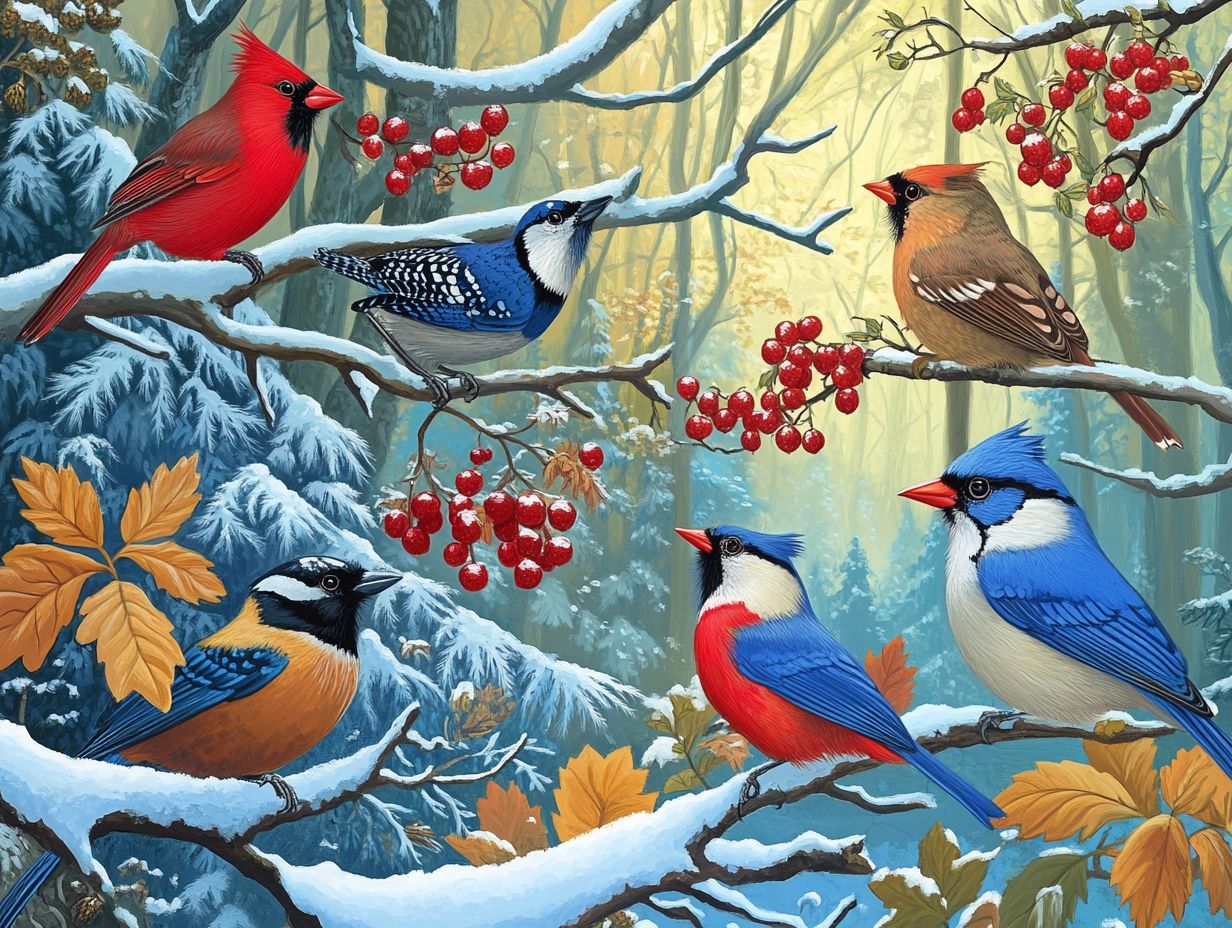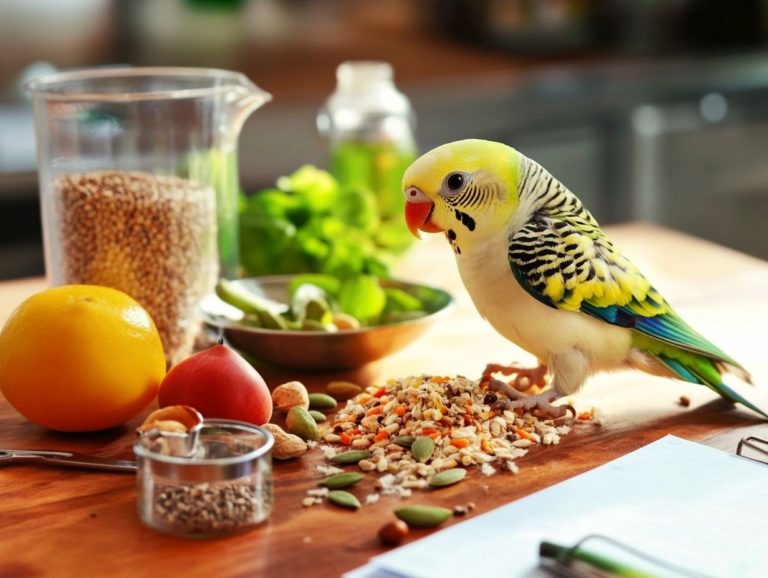How Seasonal Changes Affect Bird Diet
Understanding the diet of garden birds is essential for their health and well-being. Just like you, their food choices significantly affect their social behavior and overall vitality.
As the seasons change, the availability of various food sources fluctuates, prompting birds to adapt their diets accordingly.
This exploration delves into the dietary patterns of birds, highlighting how they adjust their feeding habits throughout the year and the impact of human activities on their food resources.
Discover how these remarkable creatures navigate their dietary needs in an ever-changing environment and learn practical methods to support the birds in your area by ensuring they receive adequate nutrition!
Contents
- Key Takeaways:
- The Importance of Diet for Birds
- Seasonal Changes and Bird Diet
- Common Dietary Patterns for Birds
- Adapting to Seasonal Changes
- Impact of Human Activities on Bird Diet
- How to Support Birds’ Dietary Needs
- Frequently Asked Questions
- How do seasonal changes affect bird diet?
- What type of food do birds typically eat during the different seasons?
- How does migration affect bird diet?
- Do seasonal changes affect the nutritional value of a bird’s diet?
- How do birds adapt to changes in their diet during the seasons?
- What can bird enthusiasts do to help birds during seasonal changes?
Key Takeaways:

- A bird’s diet is important for its health and behavior, and changes in diet can significantly affect their well-being.
- Seasonal changes greatly influence the availability of food for birds, leading them to adapt their diets.
- Human activities can disrupt natural food sources for birds, highlighting the need to support their dietary needs through proper nutrition.
The Importance of Diet for Birds
The diet of garden birds is important for their health, behavior, and overall survival. It shapes crucial elements such as breeding success, migration patterns, and social interactions. By knowing how important food sources are, you can appreciate how the ability to change their diet and species preferences enable these birds to adapt to seasonal changes.
The balance of nutritional needs impacts not just individual birds but entire populations. This underscores the importance of bird conservation efforts and the preservation of biodiversity within their habitats.
How Diet Impacts Bird Health and Behavior
The diet of birds is crucial in shaping their overall health and behavior. It affects everything from breeding success to territorial defense and social interactions.
Birds need a well-rounded diet to thrive during critical life stages, especially during summer breeding. Proper nutrition is vital for the development of eggs and chicks, fostering successful reproduction.
Certain food sources can significantly enhance social dynamics. For example, having access to abundant seeds or insects may promote flocking behavior. In contrast, scarcity can heighten competition and aggression. Seasonal fluctuations in food availability often dictate migratory patterns and habitat preferences, revealing the intricate relationship between avian feeding habits and their environment.
By grasping how diverse diets and environmental factors are interwoven, you can appreciate the complexity of avian life and the importance of conservation efforts.
Seasonal Changes and Bird Diet
Seasonal changes profoundly impact the availability and diversity of food resources for birds. This shapes their feeding habits and dietary preferences throughout the year, which can affect their migratory journeys and is influenced by the impact of diet on bird behavior.
As spring unfolds with blooming nectar sources, garden birds indulge in vibrant courtship displays. Summer, in contrast, presents a wealth of nesting opportunities and an abundance of food for fledglings.
As autumn arrives, migration patterns begin to emerge, compelling many birds to adjust their diets for energy-efficient journeys. Winter, however, poses significant challenges, bringing food scarcity that necessitates remarkable adaptations for survival.
How Different Seasons Affect Food Availability
The availability of food sources shifts distinctly with the seasons, significantly influencing the dietary habits of various garden birds and their ecological behaviors.
As winter approaches and insects become increasingly scarce, you may notice many species like finches and sparrows start eating more seeds and berries to meet their nutritional needs. During migration, birds such as the American redstart adjust their diets based on the habitats they traverse. They eagerly indulge in nectar from flowering plants in spring, while pivoting to insects in summer for that essential protein boost.
These adaptations are crucial. They help birds endure the harshness of winter and play a vital role in maintaining their winter survival during those arduous long migrations.
Common Dietary Patterns for Birds

Birds have diverse diets shaped by their habitats, food availability, and how they find food. This includes birds that eat insects.
Types of Foods Birds Eat
Birds enjoy a varied diet, eating seeds, insects, and nectar. This flexibility helps them adapt to different environments and seasonal changes.
Take the Eurasian reed warbler near Chew Valley Lake in Somerset. This bird lives in wetlands and mainly eats insects like caterpillars and aphids during breeding season. Meanwhile, garden birds like finches and sparrows prefer seeds, enjoying treats like sunflowers and dandelion seeds.
Hummingbirds have a strong preference for flower nectar, showing their dietary adaptability. This ability not only helps them survive but also maintains the ecological balance in their habitats.
Adapting to Seasonal Changes
Birds can change their diets based on seasonal shifts. This flexibility is vital for their survival amid challenges like food scarcity.
How Birds Adjust Their Diets
Birds show great dietary flexibility, allowing them to make the most of different food resources. This helps them survive in varying conditions.
Some species might change their food choices, moving from eating mainly insects to seeds or fruits when insects aren’t available.
Environmental factors like seasonal changes or habitat disruptions can lead birds to alter their foraging methods. They may migrate to new feeding areas or adapt their hunting styles to be more opportunistic.
These changes improve their chances of finding food and ensure they have enough energy for reproduction and migration.
Impact of Human Activities on Bird Diet
Human actions greatly affect the diets of garden birds, limiting their access to natural food sources and complicating bird conservation.
How Human Actions Affect Food Sources for Birds

Urbanization and agricultural expansion reduce the availability and variety of food for birds.
As cities expand and farmland increases, natural habitats are often destroyed. This leads to less food for avian species and highlights the need for ecological studies. For instance, when wetlands are converted to fields, fewer insects and plants are available for birds, disrupting migratory patterns essential for their survival.
This loss of food resources threatens the balance of ecosystems. It s crucial to act now to protect these diets! Strategies like creating urban green spaces and preserving natural reserves can help sustain bird populations and promote ecological health.
How to Support Birds’ Dietary Needs
To support garden birds, provide ample food through well-placed bird feeders and create habitats that encourage food abundance.
Ways to Provide Adequate Nutrition for Birds
To ensure garden birds receive the proper nutrition, it’s crucial to consider both the types of food you provide and the design of your bird feeders.
A variety of feeders like tube, platform, and suet feeders allows you to cater to different bird species and their feeding habits. This ensures they have access to their favorite dining options. For example, tube feeders are excellent for attracting finches and chickadees, while platform feeders are popular with larger birds like doves and jays.
You ll also want to pay attention to seasonal changes, as they significantly impact the dietary needs of these birds. In the fall and winter, foods rich in energy such as sunflower seeds and suet are particularly beneficial for supporting nesting opportunities and fledgling independence.
As spring and summer roll around, consider offering mealworms and nectar to meet the increased protein demands during nesting. You can rotate food types to match the seasons, creating a vibrant and healthy garden ecosystem that delights both you and your feathered visitors.
Frequently Asked Questions
How do seasonal changes affect bird diet?
Seasonal changes can greatly impact the availability of food sources for birds, thus affecting their diet. As the weather changes, different plants and insects become more or less abundant, making it essential for bird owners to understand recognizing and managing bird seasonal changes to help their feathered friends adapt their diet accordingly.
What type of food do birds typically eat during the different seasons?

In the spring and summer, birds tend to eat more insects and worms as they are plentiful during these seasons. In the fall and winter, birds rely more on seeds and fruits as insects become scarce. Some birds, such as hummingbirds, also rely on nectar from flowers for their diet.
How does migration affect bird diet?
Migration can interrupt a bird’s normal diet as they travel to new locations. During this time, they may rely on different food sources they encounter along the way, such as berries or insects they find during their journey.
Do seasonal changes affect the nutritional value of a bird’s diet?
Yes, seasonal changes can affect the nutritional value of a bird’s diet. For example, during the winter when insects are scarce, birds may not have access to the same high-protein diet they enjoy during other seasons, which can impact their overall health and energy levels.
How do birds adapt to changes in their diet during the seasons?
Birds have evolved to adapt to changes in their diet during different seasons. Some birds, such as finches, have specialized beaks that enable them to crack open seeds in the winter, while others may store food to prepare for times when it becomes scarce.
What can bird enthusiasts do to help birds during seasonal changes?
Bird enthusiasts can provide a variety of food sources in their backyards, such as bird feeders filled with different types of seeds and suet, to help birds during seasonal changes. They can also plant native plants and flowers that provide food sources for birds throughout the year.






